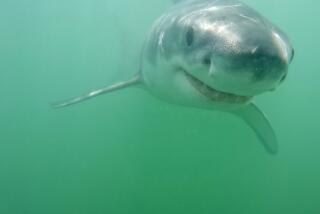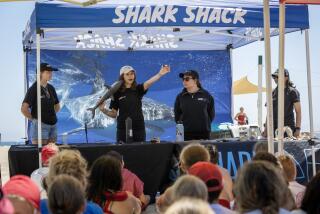SEA HUNT : These Fly Fishermen Are Casting a New Light on Catching Sharks
OXNARD â Late last week when a great white shark apparently killed a woman kayaker and her male companion near here, a few fly fishermen were out around the Channel Islands looking for sharks but finding few.
âMan, Iâve never seen it this slow,â said one, Steve Abel.
Unfortunately, and unknown to the fishermen at the time, a shark apparently attacked UCLA graduate students Tamara McCallister, 24, and Roy Jeffrey Stoddard, 24, whose kayaks were found off Zuma Beach--one showing apparent shark bites.
McCallisterâs body was found 6 miles off the entrance to Channel Islands Harbor Saturday. Stoddard had not been found as of Tuesday.
Shortly after sunrise, the group moves out of Channel Islands Harbor on O B Three, a 42-foot power cruiser. Senior owner Arch OâBryant and son Steve are at the controls. The sky is clear, the sea is calm.
âWeâre really lucky today,â Abel says.
He anticipates ideal shark-fishing conditions, except for one troublesome reservation. The digital readout on the boatâs instruments registers a water temperature of only 50.1 degrees, 4 or 5 degrees colder than normal for the area, a condition attributed to the âLa Ninaâ phenomenon bringing cold currents from the north down the California coast.
âThatâs why the fishing hasnât been any good generally,â Abel says. âThere hasnât been any live bait.â
Since mako (also known as bonito) sharks prefer warmer water, Abel doesnât expect to find any but thinks the less aggressive blue sharks will be in abundance, as usual.
He and his fishing companions, Ben Mintz and Jim Baker, tell tales of 40 to 50 dorsal fins circling the boat at one time, with double and triple simultaneous hookups.
âThereâs nothing like having 50 sharks around a boat to keep your blood boiling,â Abel says. âIf you fell in, you wouldnât even get wet. Youâd be back on the boat before you hit the water.â
Sharks will bite at almost anything, sometimes because they mistake it for natural food--an elephant seal, perhaps, like those that populate the Channel Islands. Experts think that may be what happened to McCallister and Stoddard, whose kayaks, to a shark peering up through the murk from below, could resemble seals.
Doyle Hanan, a marine biologist with the California Department of Fish and Game in San Diego, said that studies indicate that sharks are âsilhouette feedersâ that use other senses to zero in on prey and will often bite a victim, then back off and let the victim bleed to death rather than risk a fight, then come back and feed.
Dennis Bedford, a shark expert with the DFG in Long Beach, said: âPeople tend to attribute more intelligence to a shark than it deserves. Itâs just a big, dumb fish. No smarter (than other fish), just bigger.â
Abel and his friends have made a game of fooling these big, dumb fish by using light fly tackle and artificial flies. Saltwater fly fishing isnât new, but fly fishing for sharks is unusual.
âAfter trying it without much success, we developed a system of chumming, what type of fly to use and how to tie the fly,â Abel said. âOnce we got the fly pattern and the chum method down, weâve had great success every trip. Then I developed my own fly reel about a year and a half ago.â
Abel, 40, is president of Abel Automatics a machine company he runs with his brothers Lynn, Stan and Joey in Camarillo. Since its inception 12 years ago, the company has specialized in producing small, delicate parts for aircraft and medical equipment.
When he found more action was demanded of a saltwater fly reel, Abel made one for himself, using the tools available in his shop. Then he made some for friends and, before he knew it, was producing the full line of Abel fly reels that in only a year have become the standard for quality in the country and now amount to 25% of the business. The company soon will have available a big-game reel costing $1,200.
Catching a shark on a fly rod âis definitely more of a challenge,â Abel said, âthe essence of light-tackle fishing.
âIf you follow the rules, youâre allowed to use only 16-pound test, maximum. They allow you a shock tippet of less than 12 inches. I could use anchor chain if I wanted, but that wouldnât work for casting. I use a little trace of single-strand monel wire, about 9 or 10 inches long. We connect that to the tippet, (which is) the weakest link.â
The boat arrives at its destination about 24 miles offshore, some 10 miles south of Anacapa Island where the underwater shelf drops off from 150 to 700 fathoms.
This is where Abel caught the fly-tackle world-record blue shark of 140 pounds last July 1.
âMy goal is to catch a great white,â he said.
He suspects the whites use the gap between Santa Rosa and Santa Cruz Islands in the Channels as a breeding area. Hanan said the colder water and an abundance of food--seals--may also have brought whites into the area.
The record is up for grabs. Nobody has ever caught a great white on a fly rod.
The motors stop, and as the boat drifts, Abel and Baker put out chum buckets containing 6-inch frozen cubes of ground mackerel heads.
âHors dâoeuvres are served,â Abel said.
Then everybody sits back to relax and tell tales while the chum slick drifts out to attract the sharks.
âWeâve got 1 hour,â Abel said. âWhen the sharks get close, we throw out frozen anchovies--then I give âem my Abel Anchovy fly. Itâs worked every time.â
The fly is Abelâs version of a popular saltwater fly, with tinsel and realistic eyes added. Itâs not on the market.
Like most fly fishermen, Abel releases his catches, âunless itâs a world record or itâs a mako and you want to eat it. (They are) very good eating.
âBut if youâre landing a big fish and you want to keep him, thatâs when it really gets dangerous. You have to subdue him when he gets to the boat, then wrestle him on board, and heâs snapping and biting at you.
âIf heâs a record fish, you donât want to break the leader, because once the leader breaks--even though heâs on board--it disallows the record. So you have to dispatch him, try to bring him on board and get the hook out of his mouth before he breaks it.â
A club longer than a baseball bat is within reach. A gun would work better, a guest suggests, but Baker points out that would cost a potential record fish too much blood.
âBlood is 8 pounds a gallon,â Baker said. âYou lose a gallon of blood, youâve lost a lot of weight.â
Abel says he once hooked a mako he estimated to be from 150 to 200 pounds--the world record being a 65-pound brute caught off New Zealand 4 years ago. The fish tested his reel.
âHe ran off 200 yards of line in about 10 seconds,â Abel says. âThen he turned and charged the boat.â
They were aboard Bakerâs yellow 24-footer that day.
âThe boat shuddered when he hit,â says Mintz, who lives in Encino.
Makos may be underrated as game fish. Everybody knows they are mean--âthe next baddest dudes out there, next to great whites,â Abel said.
âAnd when a mako looks at you,â Baker said, âall you see is teeth.â
The hour is up, seabirds are flocking the length of the chum slick 400 yards beyond the boat, but there is no sign of sharks.
Then, 13 minutes late, a sleek, dark gray form slashes behind the boat, grabs Mintzâs Abel Anchovy, and the game is on.
âThatâs a nice size shark,â Baker says, excitedly. âAbout 100 pounds. Probably a blue.â
Then, suddenly, the fish shoots straight up out of the water 50 yards from the boat, higher than its length, which appears to be 7 or 8 feet.
âThatâs a mako!â Abel affirms. âA world record.â
He figures the fish will weigh 100 pounds--if Mintz can boat it.
âI didnât think theyâd be here in this cold water,â Abel says. âBut thatâs the thing about sharks. Theyâre unpredictable.â
The mako jumps again--twice, three times--then runs off a length of line before the OâBryants get the boat moving to follow him.
Mintz, standing all the time, his rod bent at 90 degrees, battles for 43 minutes, intermittently flexing the cramps and fatigue out of his arms. Then the mako returns, runs under the boat and emerges 50 yards in front with another magnificent leap.
The line goes slack. Mintz reels in the fly.
âHe threw the hook,â he says.
The rest of the day produces only a blue, which snaps the leader after a couple of minutes.
More to Read
Sign up for The Wild
Weâll help you find the best places to hike, bike and run, as well as the perfect silent spots for meditation and yoga.
You may occasionally receive promotional content from the Los Angeles Times.






